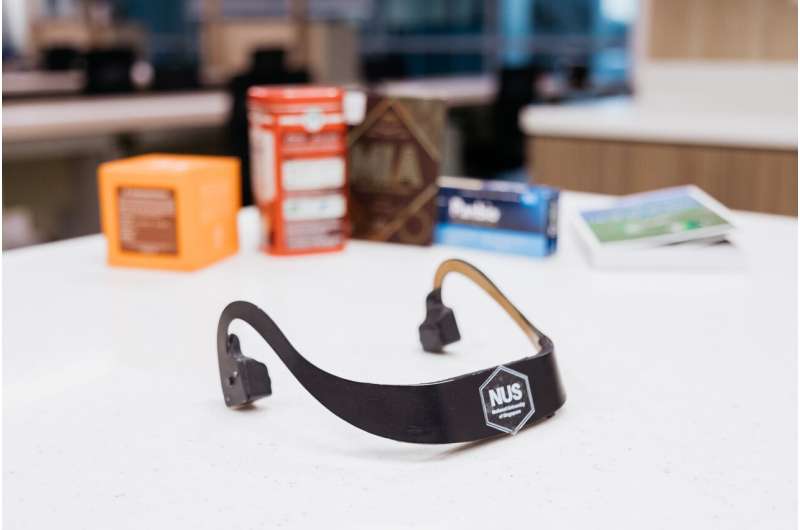

Researchers develop AI-powered 'eye' for visually impaired people to 'see' objec...
source link: https://techxplore.com/news/2024-02-ai-powered-eye-visually-impaired.html
Go to the source link to view the article. You can view the picture content, updated content and better typesetting reading experience. If the link is broken, please click the button below to view the snapshot at that time.

February 5, 2024
Researchers develop AI-powered 'eye' for visually impaired people to 'see' objects
by National University of Singapore

Shopping for groceries is a common activity for many of us, but for visually impaired people, identifying grocery items can be daunting. A team of researchers from the National University of Singapore's School of Computing (NUS Computing) have introduced AiSee, an affordable wearable assistive device that helps people with visual impairment "see" objects around them with the help of artificial intelligence (AI).
Individuals with visual impairment face daily hurdles, particularly with object identification which is crucial for both simple and complex decision-making. While breakthroughs in AI have dramatically improved visual recognition capabilities, real-world application of these advanced technologies remains challenging and error-prone.
AiSee, which was first developed in 2018 and progressively upgraded over a span of five years, aims to overcome these limitations by leveraging state-of-the-art AI technologies.
"With AiSee, our aim is to empower users with more natural interaction. By following a human-centered design process, we found reasons to question the typical approach of using glasses augmented with a camera. People with visual impairment may be reluctant to wear glasses to avoid stigmatization. Therefore, we are proposing an alternative hardware that incorporates a discreet bone conduction headphone," said lead researcher of Project AiSee Associate Professor Suranga Nanayakkara, who is from the Department of Information Systems and Analytics at NUS Computing.
The user simply needs to hold an object and activate the in-built camera to capture an image of the object. With the help of AI, AiSee will identify the object, and it will also provide more information when queried by the user.
AiSee comprises three key components:
The eye: Vision engine computer software
AiSee incorporates a micro-camera that captures the user's field of view. This forms the software component of AiSee, also referred to as the "vision engine computer." The software is capable of extracting features such as text, logos, and labels from the captured image for processing.
The brain: AI-powered image processing unit and interactive Q&A system
After the user snaps a photo of the object of interest, AiSee utilizes sophisticated cloud-based AI algorithms to process and analyze the captured images to identify the object. The user can also ask a range of questions to find out more about the object.
AiSee employs advanced text-to-speech and speech-to-text recognition and processing technology to identify objects and comprehend the user's queries. Powered by a large language model, AiSee excels in interactive question-and-answer exchanges, enabling the system to accurately comprehend and respond to the user's queries in a prompt and informative manner.
Compared to most wearable assistive devices which require smartphone pairing, AiSee operates as a self-contained system that can function independently without the need for any additional devices.
The speaker: Bone conduction sound system
The headphone of AiSee utilizes bone conduction technology, which enables sound transmission through the bones of the skull. This ensures that individuals with visual impairment can effectively receive auditory information while still having access to external sounds, such as conversations or traffic noise. This is particularly vital for visually impaired people as environmental sounds provide essential information for decision-making, especially in situations involving safety considerations.
"At present, visually impaired people in Singapore do not have access to assistive AI technology of this level of sophistication. Therefore, we believe that AiSee has the potential to empower visually impaired people to independently accomplish tasks that currently require assistance. Our next step is to make AiSee affordable and accessible to the masses. To achieve this, we are making further enhancements, including a more ergonomic design and a faster processing unit," explained Assoc. Prof. Nanayakkara.
NUS student Mark Myres, who helped to test AiSee as a visually impaired user, commented, "A lot of time, assistive devices seem very targeted at totally blind people or visually impaired people. I think AiSee is a good balance. Both visually impaired and blind people could get a lot of benefits from this."
Recommend
About Joyk
Aggregate valuable and interesting links.
Joyk means Joy of geeK